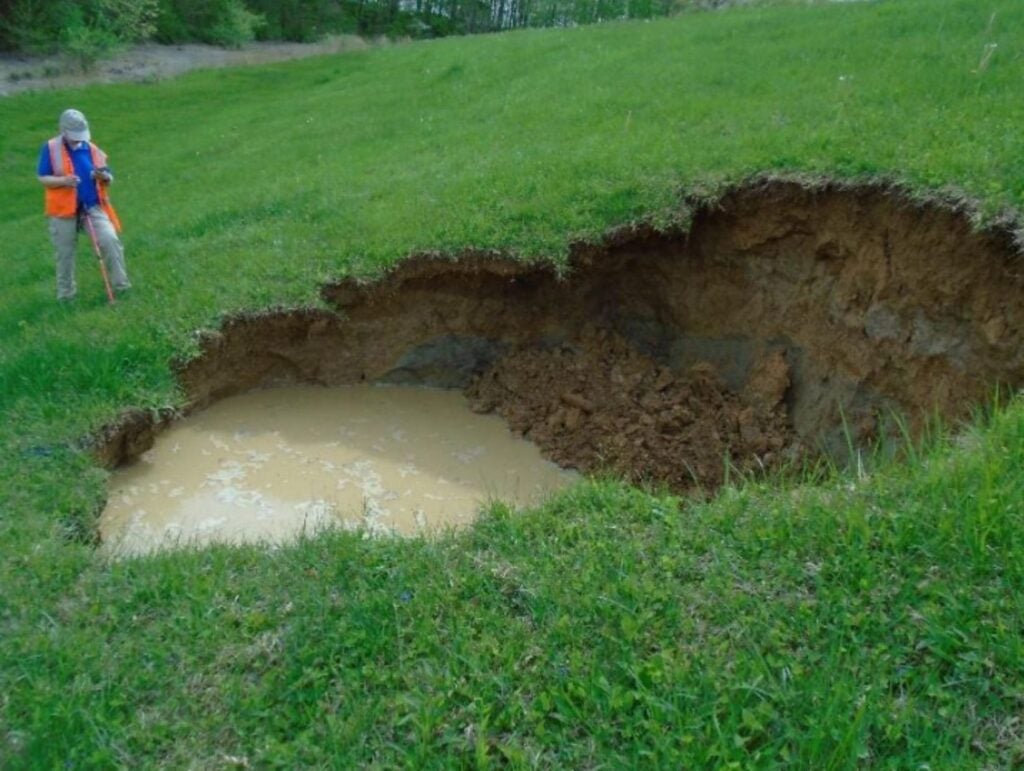New law requires hazardous Kentucky dams to have emergency plans
Published 1:18 pm Wednesday, April 5, 2023

- A sinkhole developed in a Crittenden County dam last year. County officials decided to breach the dam with an excavator to prevent its possible failure. (Photo by Kentucky Energy and Environment Cabinet)
|
Getting your Trinity Audio player ready...
|
By Kentucky Lantern
Kentucky dam safety officials faced a potentially dire situation last year: A sinkhole was rapidly growing in the slope of a dam in Crittenden County. A failure could have sent 180 million gallons of water cascading toward private developments and the local hospital.
And there was no emergency plan. That’s because until last week Kentucky was one of a handful of states that does not require emergency plans for hazardous dams.
That’s changing under a law enacted by the legislature and signed Friday by Gov. Andy Beshear that will require some hazardous dams, including the one in Crittenden County, to have emergency action plans on file.
Senate Bill 277, sponsored by Sen. Johnnie Turner, R-Harlan, saw unanimous final passage by the state House of Representatives on the last day of this year’s legislative session.
The legislation would require owners of dams with a hazard classification from the state as “significant,” “moderate” or “high” to have emergency action plans in case a dam should fail, potentially endangering lives and property downstream.
Emergency action plans are documents maintained by dam owners that identify potential ways a dam could fail, identify the responsibilities for monitoring a dam and mandate a procedure for what to do in an emergency situation. In particular, according to the State Association of Dam Safety Officials (ASDSO), these plans include water inundation maps were a dam to fail and a flow chart of who to call in what priority in an emergency situation.
The Kentucky Center for Investigative Reporting found, as of 2019, that dozens of “high” hazard dams in poor or worse condition had no emergency action plans on file. Before the legislature enacted SB 277, Kentucky was one of seven states that didn’t require emergency action plans for “high” hazard dams as of 2021, according to ASDSO.
Similar legislation had been filed in past years without gaining traction. A dam safety bill last year was amended to add unrelated language that would have gotten rid of a Kentucky permitting program for animal waste operations not overseen by the federal government. That bill did not pass.
Sen. Brandon Smith, R-Hazard, said at a Senate committee hearing that last year’s version of the bill “got tied up with some stuff there at the end.”
Commissioner of the Kentucky Department for Environmental Protection Tony Hatton also spoke during the hearing last month and recounted the crisis in Crittenden County.
“We saw last year, for instance, down in the city of Marion — through no fault of their own, they have a dam that impounds water that’s their drinking water supply, which makes it even doubly important, and they began to develop a fairly slow leak in the dam,” Hatton said.
“When there was a decision made that we needed to take a look at this, there was a period of time there, where there were so many voices speaking, we didn’t really have a plan and know which way to go.”
Local elected and emergency management officials in Crittenden County at that time clashed with state dam safety officials over how to address the growing sinkhole in the dam, and the city of Marion — which owned and maintained the dam — did not have an emergency plan on file to give specific directions on how to address the situation.
At the legislative hearing, Hatton said it was important to at least have a plan in case of an emergency. He said the state had already done much of the “heavy lifting” regarding the work needed for these plans and is ready to provide dam owners with prepared inundation maps and extra assistance developing such plans.
Crittenden County emergency management officials ultimately decided to breach the dam with an excavator to prevent a potential failure, allowing for the water to drain out of the reservoir that was Marion’s primary water source. Since that breach, the small city has dealt with a water shortage and now faces expensive options to refortify its water infrastructure.
Hatton said the situation in Crittenden County “worked out okay in the end.”
“But having had a plan in place, I think, we would’ve responded more timely and effectively,” he said.





